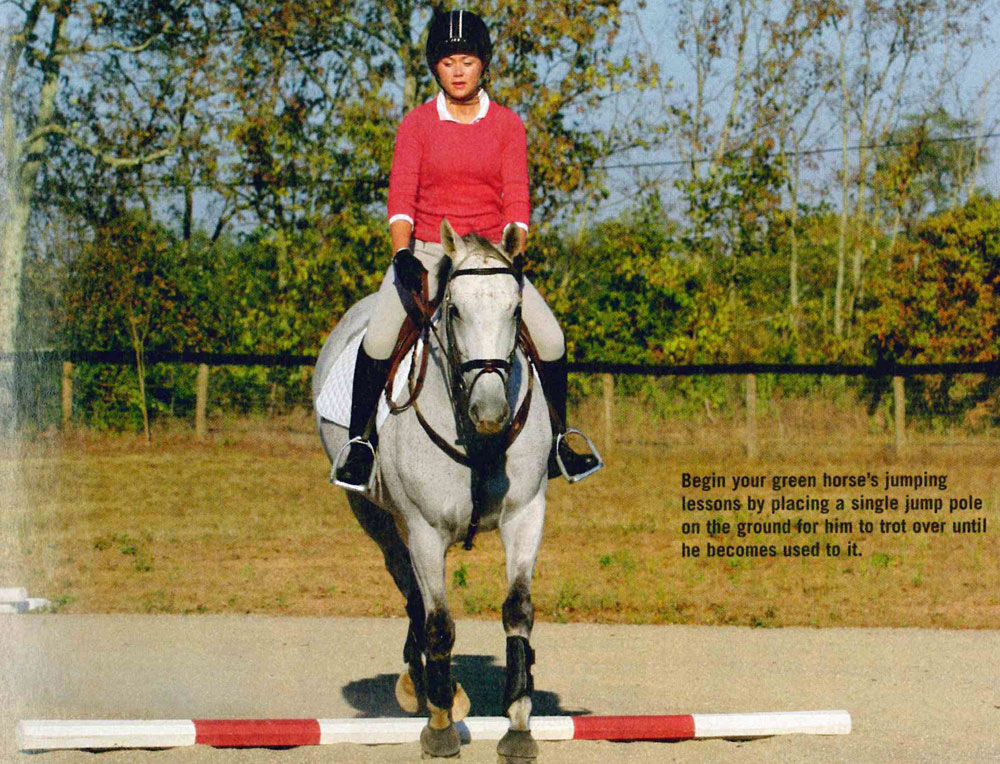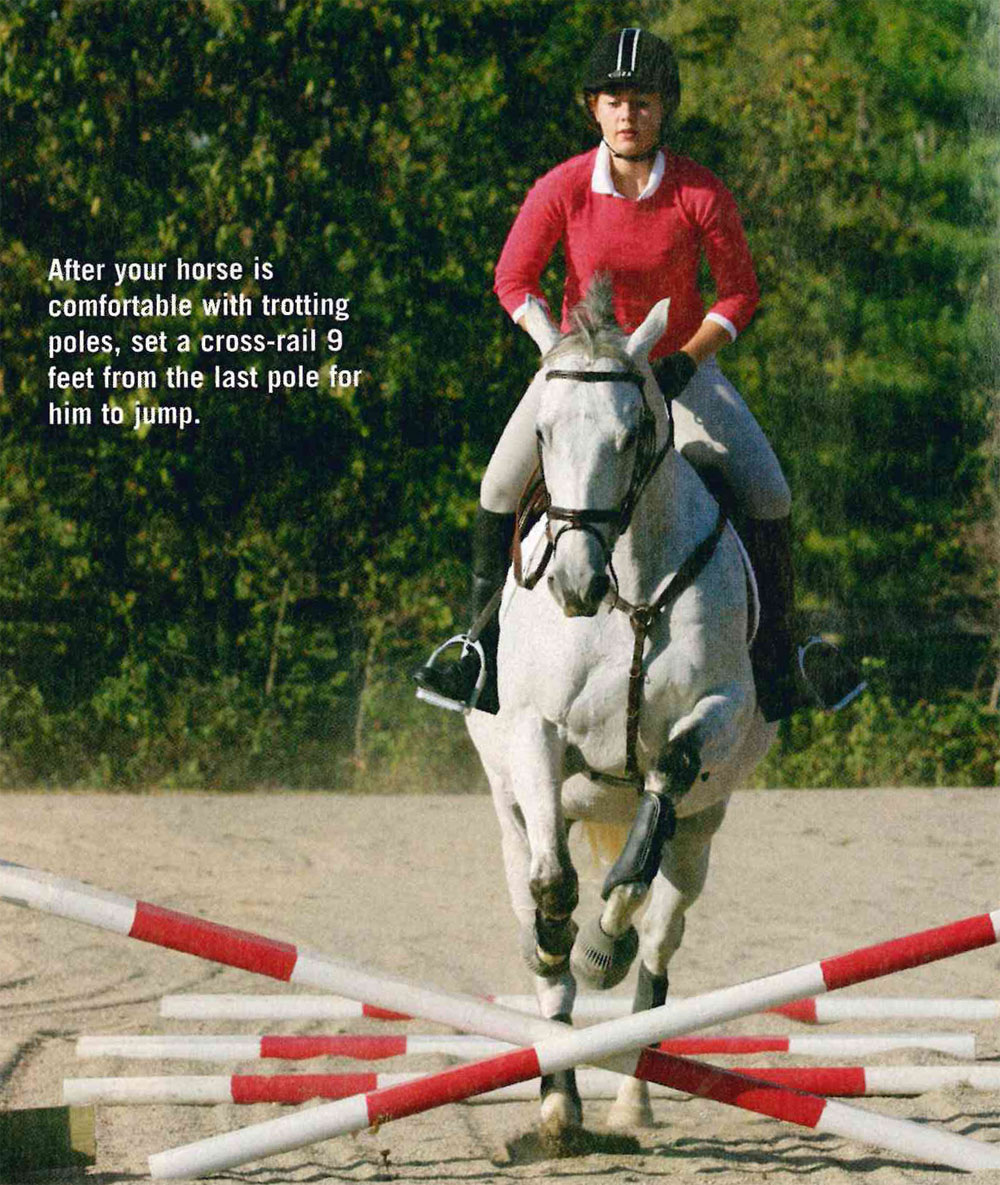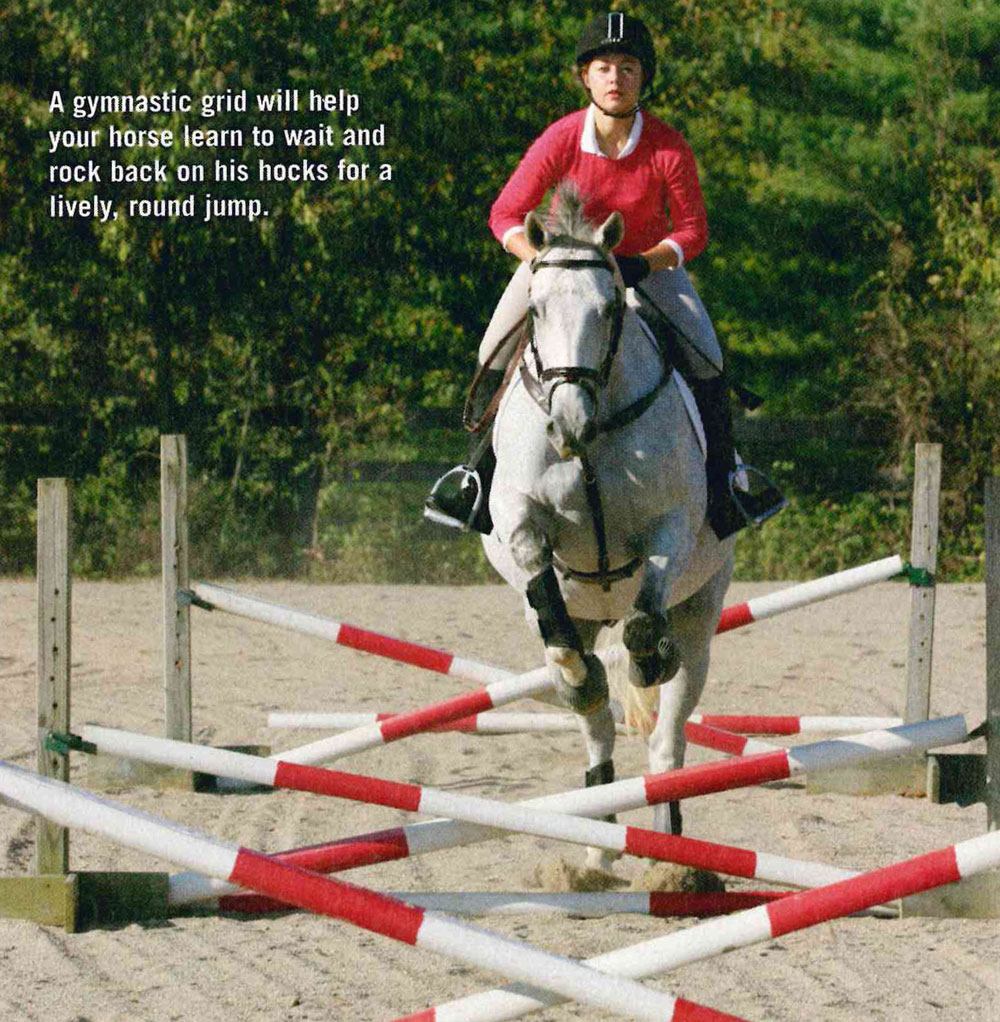If you are interested in teaching your inexperienced or young (at least 4 years old) horse to jump, low obstacles should be well within his ability as long as he is sound, physically mature and fit.

Use a level arena or field with well-drained footing, and safe jump standards and poles made either from wood or PVC specially designed for jumps. Always use an English saddle for jumping, as western saddles will be uncomfortable for both you and your horse when he’s learning to jump. Use a mild bit, preferably a snaffle, so you won’t injure your horse’s mouth if he takes a big leap over something and you get left behind on his first attempts.
Step 1: Ground Poles
Begin your horse’s jumping education by laying out a pole in the arena and riding him over it. If he is apprehensive, hand-walk him over it several times until he goes over without hesitating. You can make this a part of his regular flat work. Eventually you can add poles in various spots throughout the arena, and walk, trot and canter your horse over them. Do not get into the jumping position; just maintain a gentle contact with the bit and encourage your horse with your legs.
This exercise should be used for a week or two with a horse that is new to poles before adding any more difficulty. For more variation, try walking your horse over small fallen branches on the trail.
Step 2: Trotting Poles
When your horse can handle a single pole, lay out three or four trotting poles spaced 5 feet apart. Larger or smaller horses may need the distance adjusted to their stride. Trot your horse (posting) straight up to the middle of the poles, and use plenty of leg if he backs off or becomes hesitant. Most horses will figure things out after one trip through, so be very positive and encourage him with lots of praise for a good effort. Once your horse understands how to pick up his feet and maintain a consistent pace, try trotting five or six poles.

Step 3: Cross-rail Jump
As your horse progresses, add a cross-rail to your exercises with three or more trotting poles: simply set up a small cross-rail 9 feet after the last pole. This type of jump is the most inviting for your horse, as it will direct him toward the middle and make him less likely to run out if he drifts too far to the side of the jump. If he stops on the first try, allow him to approach the jump and inspect it, then ask him to step over it from a standstill. It may take a few tries, but if you are systematic about building up to this point with your exercises, he should learn to trot the cross-rail. If you are having any problems with this step, try “Follow the Leader.” Alternate turning left and right, going straight, and halting after the jump so your horse won’t anticipate always doing the same thing.For this exercise, get into the two-point position and grab onto your horse’s mane over the jump; many green horses will take a big leap the first few times over a real jump, so be prepared.
Step 4: Gymnastic Grids
Help your horse think about the jumps instead of rushing to get over them by using an exercise called a “gymnastic grid.” To set up a grid, begin with two cross-rail jumps spaced about 10 feet apart (this can be shortened or lengthened depending on the size of your horse and the length of his stride). Trot your horse in, using a trot pole set 9 feet before the grid if desired. Your horse should soon understand the concept of “bouncing” over the fences—that is, jumping and taking off with no stride in between the cross-rails. Once your horse understands what to do, try adding a third fence.The best thing about this exercise is that it will correct your horse’s form without you having to interfere with him. He will learn to wait and rock back onto his hocks in the take-off for a lively, round jump. The cross-rails will help keep him straight from start to finish. These jumping lessons will help him throughout his career.
To add a level of difficulty to the bounce exercise, make the last fence a 2-foot vertical. If he jumps that well and stays straight, try a cross-rail/vertical/vertical combination. Always make sure you aren’t catching your horse in the mouth over fences or bouncing in the saddle upon landing. As your horse becomes more athletic, he should start to enjoy jumping.

Step 5: Riding a Course
Once your horse has a feel for going over a jump and knows where to put his feet, take away the trotting poles and set up five or six individual jumps around the arena. This will teach your horse to keep going at a controlled pace after each jump. If he rushes to the next obstacle, halt him after each jump until he learns to not speed off. If he is too slow over the jumps, land in a canter and encourage him to continue in the canter while riding away from jumps.
It’s best to approach each jump in a course at a trot while your horse is learning. If you ask green horses to jump out of a canter (particularly “hot” breeds, such as Thoroughbreds), they often rush their fences, jumping long and flat—the opposite of the desired round arc that is powered by the hindquarters. The fences should be cross-rails and verticals of 18 inches to 2 feet during this learning period. Only progress to cantering fences when your horse is steady at the trot.
Don’t be afraid to take your time and work through these exercises very slowly. Some horses can take up to a year to learn how to jump correctly, and you don’t want to rush the process. The time you spend teaching your horse now will pay off throughout his jumping career. When in doubt, always be patient. It is easier to progress slowly than to correct training problems that have been ingrained for a long time.
Further Reading
Rider Reminders for Jumping
Follow the Leader
Jumping Tips
This article originally appeared in the April 2009 issue of Horse Illustrated. Click here to subscribe.






Like the point of having someone on the ground. It’s a good idea to make sure that person is more experienced than you so as to give any coaching necessary. Too many people who have never jumped before are attempting to teach a horse to jump, many without the proper guidance. You can’t properly teach something if you don’t know it yourself.
don’t grab on to your horses mane when going over a jump it makes your form bad and it just looks bad.
Not true. It is better to grab a handful than get left behind on a green horse, which is unpredictable on how he will jump
The point here was that you are about to take a very green horse over, perhaps, its very first jump. It is only a wise precaution to grab a handful of mane. You are not in a show arena and needn’t be worried about “form.” Just hang onto your ‘greenie’ and enjoy the ride! Form and ‘looking good’ can come later. Just have a safe ride! 🙂
I started training during the summer and I am trying to figure out how to jump, any advice?